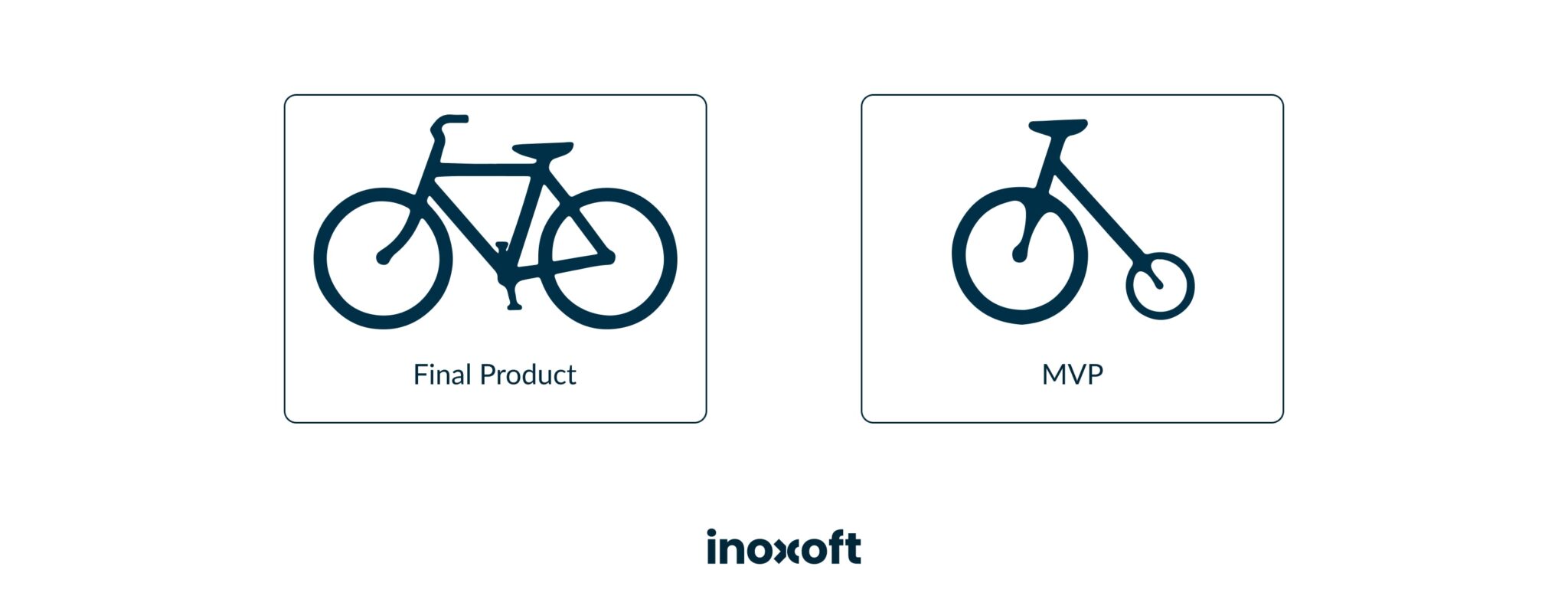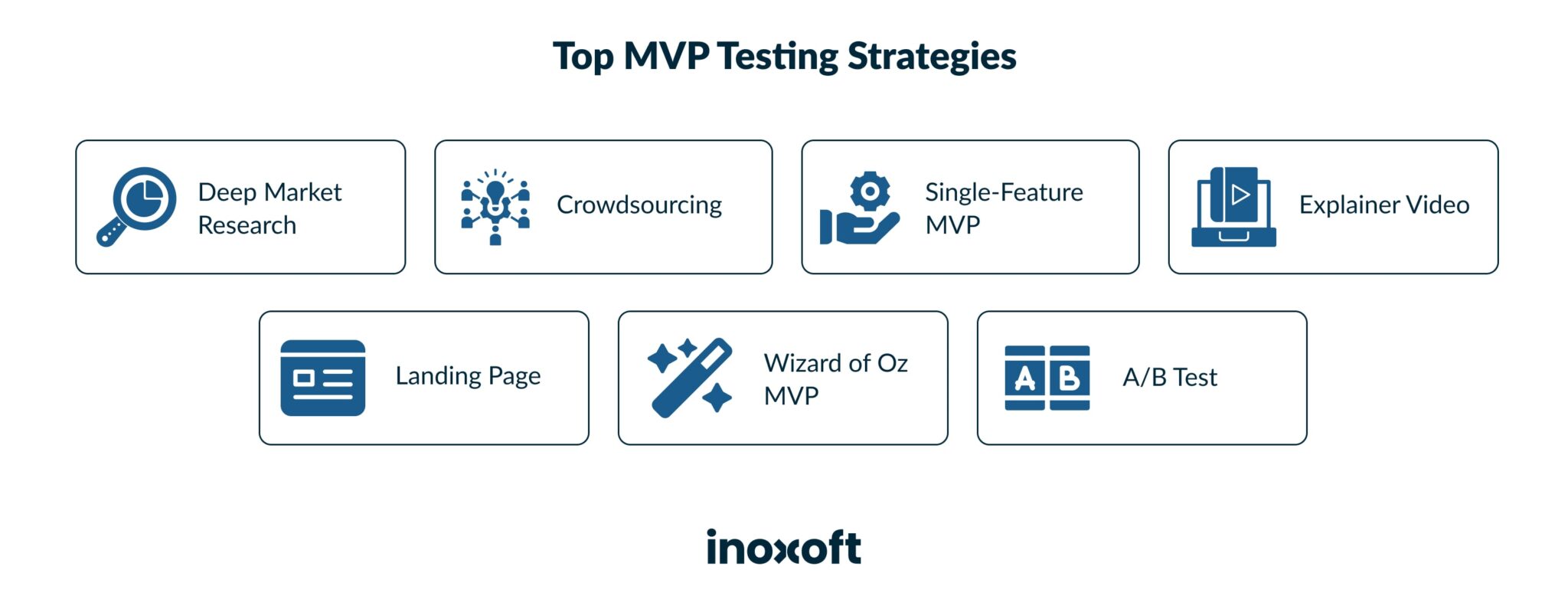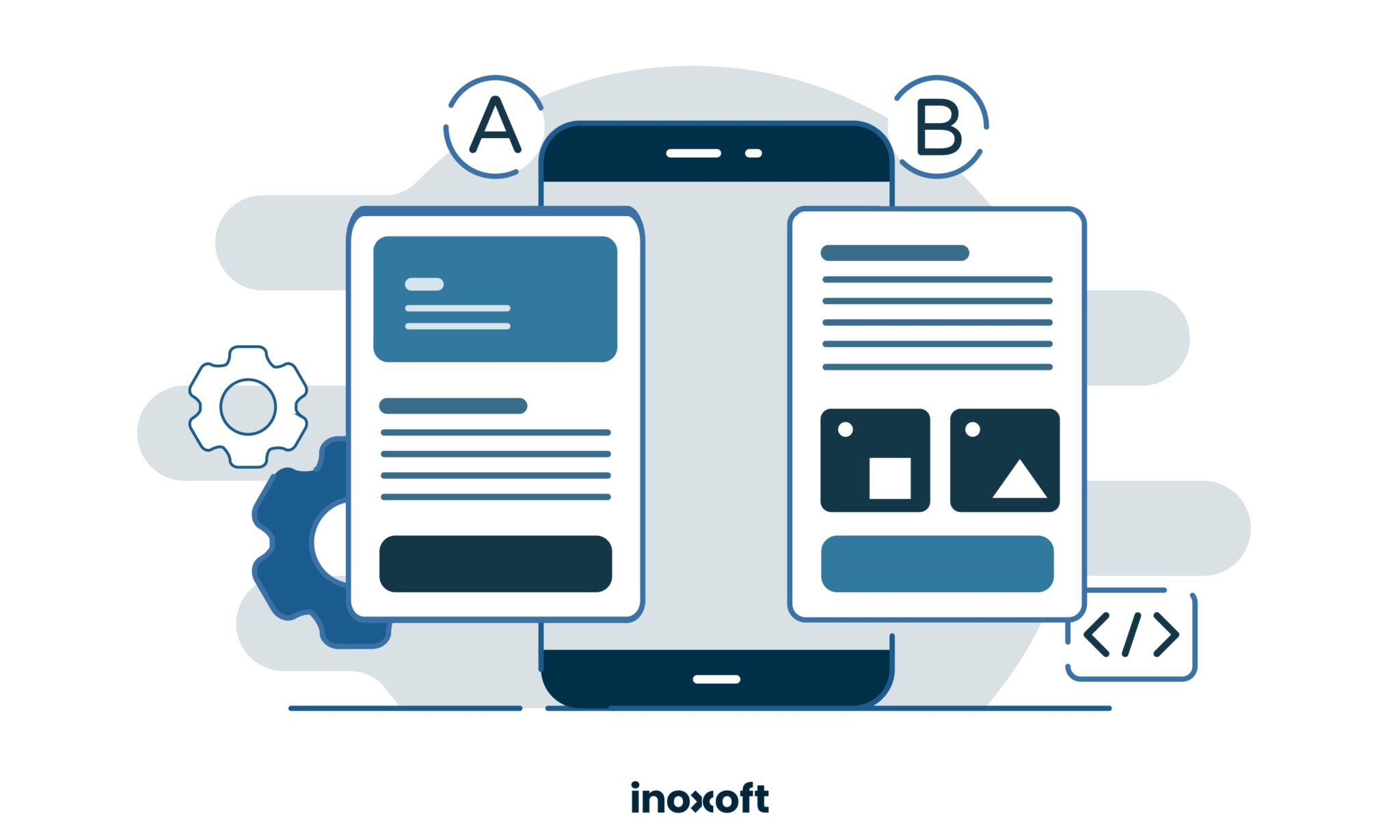In a competitive market filled with various propositions, it seems impossible to create an innovative product that won't fail and will become users' favorite. The bitter truth is that over 90% of startups fail. Yet, we bet most of them thought their business idea was bound to succeed without any validation.
Nevertheless, to increase the chances of the product’s success, you need to consider the minimum viable product development. As a matter of fact, it provides us with essential data about the product to make future decisions. We have already learned how to build MVP, so let’s find out how to test our MVP. To interest you in continuing reading, we suggest a little test: If the thought of the percentage of great startups that failed throws you into a cold pit, stay tuned!
- What is a Minimum Viable Product (MVP)?
- Why is It Important to Evaluate Your Minimum Viable Product (MVP)?
- What are the Best MVP Testing Strategies?
- Deep market research
- Crowdsourcing
- A/B test
- Landing page
- Pre-orders
- Explainer video
- Wizard of Oz MVP
- Single-feature MVP
- Social media microsurveys
- Ads
- MVP Testing: What Tools to Use
- QuickMVP
- Instapage
- Marvel
- Which Typical MVP Test Errors Should You Steer Clear of?
- Not conducting adequate market research
- More focus on candid feedback
- Selecting the incorrect development team
- Consider Inoxoft for the Proper Creation and Testing Your MVP
What is a Minimum Viable Product (MVP)?
MVP is a version of a new software or service that includes only the core features and functionalities necessary to meet the needs of the target audience and gather feedback. Creating an MVP aims to quickly bring a basic version of the product to market to test its viability and gather insights from users with minimal development effort and cost. The feedback obtained from these early users can then be used to iterate and improve the product.
Why is It Important to Evaluate Your Minimum Viable Product (MVP)?
To dig deeper, we have to make a couple of things clear. The most important: what exactly is an MVP? It’s a technique used early in the product development cycle in which a product with basic features is placed on the market and is ready to use. The introduction of the product is supposed to gather data, insights and feedback from early-adopter users. Thanks to that, we can verify the product’s idea and its relevance.
The significance of the MVP test is that it defines the approximate success of the future project without developing the whole product. This procedure ensures that the product works just as intended. And, in addition, satisfies the target audience’s needs, minimizing the number of possible risks and critical problems. What is MVP testing? It allows us to make vital lessons and decisions about the project by showing behavior and values from the customers’ perspective. It also leads to a constant improvement of the product based on the user’s experience, which is a key to the high-level quality of the final result.
Another pivotal purpose of the MVP is to save our wallets and time. Even without extra features, a well-designed product might become popular in the market, which is a win-win situation from the marketing and financial perspective. On the other hand, the earlier we discover the customers’ feedback, the less amount of investment we will waste in vain. Low-budget startups confident in their successful MVP test might attract more investors to inject some valuable cash flow into a business. Thus, minimum viable product testing helps iterate and enhance the product with the least effort.
What are the Best MVP Testing Strategies?
Despite diverse MVP testing strategy variants, we will now discuss the top and best ways of testing MVP that help assess pivotal points. So, how to test MVP to see if our minimum viable products meet user requirements and quality standards?
Deep market research
To start our MVP journey, we need to have quite a baggage of knowledge about the area we want to settle in. Who is the target audience? Do they need the product, and would they pay for it? Who are the competitors, and what is their proposition? Users won’t go along if the product doesn’t resolve the problem or is just another alternative to the existing solution.
Conduction of surveys and interviews seems like a perfect way to attain information, which leads to higher chances of triumph. Asking unfiltered and unrestrained questions about the minimum viable product may give you exclusive first-hand feedback from the potential audience. Such insights are impossible to obtain in any other way. Take an interest in whether they think your MVP would help them with those problems. If not, ask what criteria will improve the final product.
Crowdsourcing
One of the MVP testing methods – and the best for low-budget startups – is crowdsourcing. This outsourcing strategy aims to engage many online users in a specific project with various resources. Those start from finances, time and recommendations, ending with social capital, experience, ideas and knowledge. Platforms such as Patreon, Kickstarter, or IndieGogo allow people to interact with a product and donate money for its future development.
Nevertheless, they also require long-term work with the same prototype without fast iteration. This way of testing MVP is only not profitable in the form of getting investments but also in observing and analyzing the market’s reaction to the idea.
A/B test
We use this minimum viable product testing strategy to resolve whether one product version functions better than another. Or whether users act in a certain way in a specific situation versus not being in that situation. A/B test allows us to measure the essential metrics of both versions: bounce and conversion rates, frequency of usage, etc. Testing two polar opposite versions makes determining the most exciting features for users more accessible. In case of the absence of positive results, it’s better to return to the beginning of MVP development and try fixing what’s wrong.
Landing page
Usually, we need to see the offer with our own eyes to desire to purchase it. That’s where the landing page comes on: it’s a site, usually one-page, where users obtain all the detailed information about the product. From a marketing perspective, a landing page is a terrific tool for MVP promotion among the audience. A brief description of product specificities, advantages, and CTAs will attract users to interact with the company and try out the product. In the shortest possible time, you not only have your potential customers’ contacts collected but also achieve validated information about the project.
Pre-orders
Pre-orders involve convincing users of a product’s appeal to the extent that they are willing to make advance payments. Nevertheless, there exists a challenge in persuading users to invest their money well in advance, especially when the product is still in its conceptual stage. To overcome this hurdle, a compelling product presentation is essential to instill confidence in potential customers.
Explainer video
The most outstanding presentation is the visual one. Therefore, an explainer video can be a fantastic testing tool for MVP as it demonstrates to customers the concept of the project, its necessity, and its features.
The more entertaining the video, the better! Don’t be afraid to express your creativity and crazy ideas here! Customers prefer to watch an incredibly upbeat clip rather than a dull and tedious one. Showing all the essential elements of a future product in the video and seeing the statistics of views, likes and comments is an efficient way of validating the MVP.
Wizard of Oz MVP
No Dorothy or Toto in sight, yet this way of testing MVP is considered one of the swiftest and most productive. In Wizard of Oz or Manual-first MVPs, we make an impression of the finished product: users have no idea that other people manually solve their demands. The interface is entirely developed from the front, making consumers’ experiences closely approximate to reality with no idea what’s happening behind the scenes. Thanks to customer validation, we can decide how to make the best automated process for a flawless product usage experience.
Single-feature MVP
One of the most common minimum viable product testing strategies, a single-feature MVP, is excellent for reducing the development time and narrowing down the customer base. To solve one specific problem your target audience has, you focus on a single key feature and receive feedback to create a unique and valuable proposition.
Minimal resource expenses such as money and time are significant pros of single-feature MVP. A sophisticated application that thoroughly focuses on the specific problem without any extra features is something we lack nowadays. Later, you can easily upgrade the product with other valuable features your audience desires.
Social media microsurveys
By getting responses from social media users, you can find out if they’re interested in the features or products you’re offering. Since microsurveys are quick and to the point, people are more likely to answer them, giving you fast results for testing your MVP. But before this strategy, figure out which social media platforms your target audience uses. This way, you can connect with potential customers and get better survey results.
Ads
Google and Facebook platforms provide tools to understand the demographics of your audience through advertising campaigns: even before your product is officially launched, you have the opportunity to display ads and gauge user engagement. With an effective insights dashboard, you can monitor and analyze key metrics such as clicks, engagement levels, and other significant user behaviors.
In the initial stages, both Facebook and Google may provide financial support for testing campaigns, giving you a starting point for your efforts — a valuable resource as you begin testing and refining your strategies.
MVP Testing: What Tools to Use
We know that the level of product quality correlates with its total cost. That’s nice, but what should we do with a tight budget? If you are wondering about the best MVP testing tools and platforms, the following paragraphs will help!
QuickMVP
The main peculiarity of this easy and handy MVP resource is the ability to build landing pages and create a Google Ad altogether. QuickMVP aims to validate business ideas and identify the essential metrics to decide if a concept is worth developing. This service allows us to conduct interviews, create landing pages, and calculate business metrics for each landing page experiment. You can test your minimum viable product within five minutes and have a complete picture of users’ natural responses to your product. No code is needed, by the way!
Instapage
One of the most powerful MVP testing platforms, Instapage helps create and run landing page campaigns. This resource is capable of working with Google Analytics, Google Tag Manager, Google Adwords and Facebook Pixel, which is beneficial for campaign improvement. Supporting A/B tests, Instapage allows the creation of excellent landing pages within a secure real-time collaboration with team members. Still, no code is needed!
Marvel
With a promising name, Marvel is a MVP prototyping tool for creating both app and web prototypes. This browser-based software with a sleek interface allows downloading projects for offline usage and enables team collaboration. It can also integrate with other working tools such as Figma and Sketch.
Marvel gives an excellent opportunity to test your MVPs thanks to other users, who will look at your projects and graciously provide constructive feedback and recommendations from both the user’s and developer’s perspectives.
Which Typical MVP Test Errors Should You Steer Clear of?
In the process of testing a minimum viable product, it’s crucial to be aware of common errors that can impact the accuracy and effectiveness of your testing efforts. Here are typical MVP test errors you better avoid:
Not conducting adequate market research
Testing an MVP without thorough market research can lead to a disconnect between the product and actual market needs — without a solid understanding of your target audience and their pain points, your MVP may miss the mark. Prioritize comprehensive market research to identify customer needs, preferences, and existing solutions.
More focus on candid feedback
Relying too heavily on subjective or candid feedback without considering quantitative data can lead to biased conclusions. Depending solely on individual opinions may not represent the broader user base, which can result in misguided features and a lack of user interest. It’s better to utilize analytics and objective data to complement subjective opinions to get a more comprehensive understanding of your MVP’s performance.
Selecting the incorrect development team
Choosing a mismatched development team can lead to delays, miscommunication, and a final product that deviates from your vision. A team lacking the necessary skills and expertise may compromise the quality of your MVP. You should carefully vet and select a development team with relevant experience in your industry and technology stack.
Consider Inoxoft for the Proper Creation and Testing Your MVP
To build an MVP, we must know all the latest technology trends, and master excellent analytical skills and software development solutions. To test an MVP, we must multiply all the above. Inoxoft is a worldwide company that provides startups with the best software development services. We operate in such domains as Education, Fintech, Healthcare, Logistics and Real Estate.
Our team will provide you with the top software development services for startups depending on your needs and desires and help implement your idea. With more than seven years of experience, we ensure that we deliver top-quality services, including MVP development and testing. Inoxoft delivers essential discovery phase services for startups in order to understand defined project scope with precise cost and time estimation. If you are ready to start working on your MVP and wonder where to begin, don’t hesitate to contact us!
Frequently Asked Questions
Why is MVP better for unit testing?
The smaller codebase of an MVP makes it easier to isolate and test individual units, which can contribute to faster development cycles, quicker identification of bugs, and more effective maintenance of code quality.
What is the importance of MVP testing?
The significance of testing your MVP is that it defines the approximate success of the future project without developing the whole product. This procedure ensures that the product works just as intended and satisfies the target audience's needs, minimizing the number of possible risks and solving critical problems.
What is the best strategy of your MVP testing?
It depends on your product's concept: the best strategy for MVP testing may involve a combination of testing methods such as usability testing, A/B testing, and social media microsurveys. Additionally, thorough market research, scalability testing, and a focus on core features contribute to a comprehensive and effective MVP testing approach.












